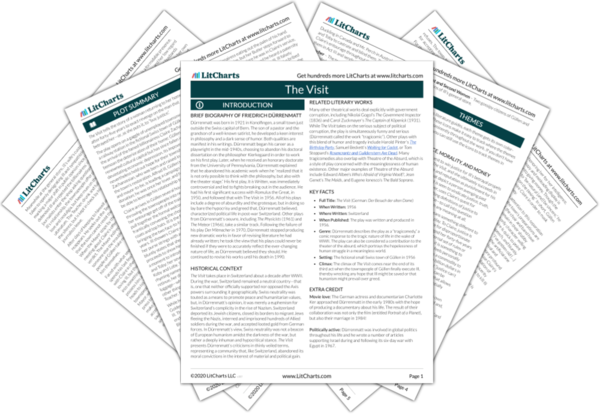Justice, Morality, and Money
Claire’s quest to win justice for Ill’s betrayal propels the plot of The Visit, and she ultimately succeeds in taking Ill’s life and reputation as punishment for his wrongs. In many stories that depict a person avenging past wrongs, the ultimate verdict is seen to vindicate justice, truth, and morality. The Visit, however, uses Claire’s quest for justice—and the vapid and shifting definitions of justice to which the townspeople subscribe—to call…
read analysis of Justice, Morality, and MoneyIrony and Artifice
In the town of Güllen, nothing is as it seems: characters’ motivations are not what they claim, false appearances disguise reality, and even the town’s economic downturn is revealed not to have happened as the townspeople believed. All of this creates an atmosphere of distrust and manipulation in which everyone is acting in their own best interest, no matter how sincere or compassionate they seem.
When the play opens, the townspeople of Güllen are furiously…
read analysis of Irony and ArtificeLove and Prostitution
At the heart of The Visit is the complex relationship between Claire and Ill, whose deep adolescent love was broken by Ill’s betrayal of her. This youthful love is the play’s only example of real love: after their relationship ended, Ill married for money, and Claire became a prostitute before flippantly marrying a series of men that she clearly neither loves nor respects. While the love between Ill and Claire is shown to have…
read analysis of Love and Prostitution
Humanism and Dehumanization
Güllen sees itself as a humanist town—a place with a value system that rejects selfishness and emphasizes the human capacity for compassion, mutual understanding, and respect. Claire’s attempt to bribe the town into killing its most popular citizen for revenge, however, is anti-humanist: it is selfish, cruel, and it disregards the moral and legal imperatives that the town claims to value. As the townspeople struggle to balance greed with idealism and personal profit with…
read analysis of Humanism and Dehumanization











